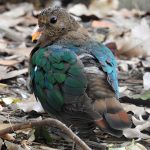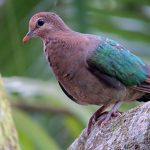EMERALD DOVE
The Emerald dove, also known as the Common emerald dove is native to the Indian subcontinent, Southeast Asia, and parts of Australia. It is medium-sized with striking and vibrant plumage. Adult males have bright emerald green feathers on their back and wings, which give them their name. Their head and neck are a lighter shade of green, and they have a white patch on their cheeks. The chest and underparts are a paler green. Females, on the other hand, have a more subdued appearance with mostly brownish-green plumage.
The Emerald dove is widely distributed across its range of northern Australia. They inhabit a variety of forested habitats, including tropical and subtropical rainforests, woodlands, and mangroves.
Emerald doves are generally shy and elusive birds. They are often seen foraging quietly on the forest floor for fallen fruits, seeds, and small invertebrates. When disturbed, they tend to fly quickly to cover and remain hidden.
These doves have a soft and melodious cooing call that is often described as soothing and pleasant. Their calls are used for communication and during courtship displays.
Emerald doves typically build nests in trees, laying one or two eggs at a time. Both the male and female take turns incubating the eggs and caring for the chicks. The young doves fledge and become independent after a few weeks.
Their diet primarily consists of fruits, seeds, and small insects. They are important seed dispersers in the ecosystems they inhabit, helping to spread the seeds of the fruits they consume.
Like many other bird species, it can be vulnerable to habitat loss due to deforestation and habitat degradation.
Emerald doves are known for their striking appearance and are admired by bird enthusiasts and birdwatchers for their beauty. They play an essential role in the ecosystems they inhabit by contributing to seed dispersal and maintaining the balance of their native habitats.




